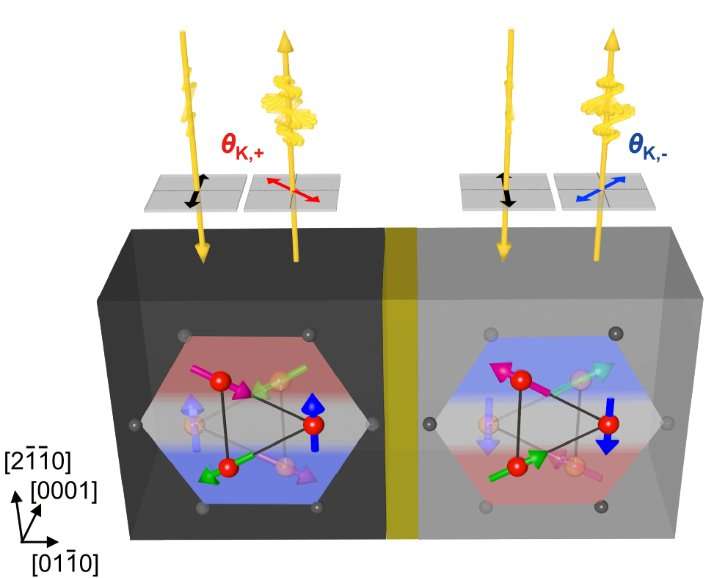Study identifies metallic antiferromagnet with potential for memory devices

Antiferromagnets have generated significant interest for future computing technologies due to their fast dynamics, their ability to generate and detect spin-polarized electric currents, and their robustness against external magnetic fields. Despite these bright prospects, the vanishing total magnetization in antiferromagnets makes it difficult to evaluate their internal magnetic structure compared with their ferromagnetic counterparts.
Limited understanding of the internal magnetic structure of antiferromagnetic materials and devices is a major obstacle to manipulating and efficiently utilizing variations in their magnetic state. In work that sheds light on a new set of antiferromagnetic materials, an international research team led by researchers at the National Institute of Standards and Technology (NIST), the United States Naval Research Laboratory, the Johns Hopkins University, the Institute for Solid State Physics (ISSP), and the University of Tokyo have identified a metallic antiferromagnet (Mn3Sn) that exhibits a large spontaneous magneto-optic Kerr effect (MOKE), despite a vanishing total magnetization at room temperature. A metallic antiferromagnet with a large spontaneous MOKE promises to be a vital tool for future antiferromagnetic memory devices, where the device state could be read optically and switched either optically or with a spin-polarized electric current.
The magneto-optic Kerr effect probes the local magnetization projection onto the wavevector of an incoming beam of light. In most antiferromagnetic materials, the mutually opposing spin directions lead to a cancelling out of this effect, and thus it is believed MOKE is useless for the study of antiferromagnets. As the scientists of the international team have demonstrated, however, the antiferromagnetic metal Mn3Sn exhibits a large MOKE with a MOKE rotation angle of 20 milli-degrees at zero magnetic field, despite its near-zero magnetization, which is indeed comparable to ferromagnetic metals.
A simple ordering of an antiferromagnet is collinear, in which neighboring spins within an antiferromagnetic domain have their spins aligned anti-parallel, in which the arrow of one spin is pointing up while the adjacent spin points downward. Mn3Sn exhibits an unusual chiral spin order, in which each spin is rotated 120-degrees counter-clockwise to her neighbor in sets of three spins centered on the vertices of an equilateral triangle formed by Mn atoms of the Mn3Sn crystal. While there is zero net magnetization in both the collinear and the non-collinear 120-degree spin systems – the same as zero dipole moment – an emergent, non-vanishing octupole moment is present in the spin system of Mn3Sn. This octupole moment interacts with light in the same way as a ferromagnet and gives rise to the large MOKE in Mn3Sn.
The international research team, including NIST scientists Daniel Gopman and Robert Shull, and U. Tokyo researchers Tomoya Higo and Satoru Nakatsuji, report their findings in the January 26, 2018 issue of Nature Photonics .
The MOKE in Mn3Sn enables real-time imaging of magnetic domains. By using MOKE microscopy, the researchers demonstrate for the first time the domain-reversal process in Mn3Sn. This finding indicates that the observed Kerr effect may well be useful not only for the study of the dynamics of antiferromagnetic domains but also to remotely read the information magnetically stored in the antiferromagnet. Ongoing investigations seek to develop the processing conditions for producing thin film and nanoscale Mn3Sn with the advantageous magnetic properties discovered in bulk single crystals.
More information: Tomoya Higo et al. Large magneto-optical Kerr effect and imaging of magnetic octupole domains in an antiferromagnetic metal, Nature Photonics (2018). DOI: 10.1038/s41566-017-0086-z
Journal information: Nature Photonics
Provided by National Institute of Standards and Technology
This story is republished courtesy of NIST. Read the original story here.




















